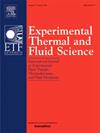2C-2D PIV/PTV measurements of high Reynolds number turbulent channel flow with sub-viscous-length wall-normal resolution
IF 3.3
2区 工程技术
Q2 ENGINEERING, MECHANICAL
Experimental Thermal and Fluid Science
Pub Date : 2025-03-28
DOI:10.1016/j.expthermflusci.2025.111481
引用次数: 0
Abstract
This study presents a high spatial resolution hybrid particle image velocimetry/particle tracking velocimetry (PIV/PTV) methodology for investigating high Reynolds number turbulent channel flow. Utilising two 103-megapixel cameras, the experiment captures the entire channel height with a spatial resolution finer than the viscous length scale. To ensure accurate mapping of the PIV image pairs to a common coordinate system, a novel holography-based pixel-to-pixel imaging sensor registration technique is developed, which achieves an uncertainty of better than . At the same time, an efficient second calibration process accounts for lens distortion. The hybrid PIV/PTV analysis leverages PIV velocity vectors as predictors to identify particle pairs for PTV, with velocity vectors sorted into bins of 0.6 viscous length height in the wall-normal direction for statistical velocity analysis. The resulting first- and second-order velocity statistics and the streamwise velocity spectra agree with the equivalent results obtained from direct numerical simulations (DNS) of turbulent channel flow at similar friction Reynolds number, validating the effectiveness of the proposed methodology in capturing the structure of turbulent channel flow with resolution equivalent to DNS resolution.
高雷诺数湍流通道流动的2C-2D PIV/PTV测量与亚粘性长度壁法向分辨率
提出了一种高空间分辨率混合粒子图像测速/粒子跟踪测速(PIV/PTV)方法,用于研究高雷诺数湍流通道流动。利用两个1.03亿像素的相机,实验以比粘性长度尺度更精细的空间分辨率捕获了整个通道的高度。为了保证PIV图像对在同一坐标系下的精确映射,提出了一种基于全息成像的像素对像素成像传感器配准技术,该技术的不确定度优于0.5μm。同时,一个有效的二次校准过程解释了透镜畸变。混合PIV/PTV分析利用PIV速度矢量作为预测因子来识别PTV的粒子对,速度矢量在壁面法线方向上被分类为0.6粘性长度高度的容器,用于统计速度分析。所得的一阶和二阶速度统计量以及沿流速度谱与摩擦雷诺数相似的湍流通道流动直接数值模拟(DNS)的等效结果一致,验证了所提出的方法在捕获分辨率相当于DNS分辨率的湍流通道流动结构方面的有效性。
本文章由计算机程序翻译,如有差异,请以英文原文为准。
求助全文
约1分钟内获得全文
求助全文
来源期刊

Experimental Thermal and Fluid Science
工程技术-工程:机械
CiteScore
6.70
自引率
3.10%
发文量
159
审稿时长
34 days
期刊介绍:
Experimental Thermal and Fluid Science provides a forum for research emphasizing experimental work that enhances fundamental understanding of heat transfer, thermodynamics, and fluid mechanics. In addition to the principal areas of research, the journal covers research results in related fields, including combined heat and mass transfer, flows with phase transition, micro- and nano-scale systems, multiphase flow, combustion, radiative transfer, porous media, cryogenics, turbulence, and novel experimental techniques.
 求助内容:
求助内容: 应助结果提醒方式:
应助结果提醒方式:


